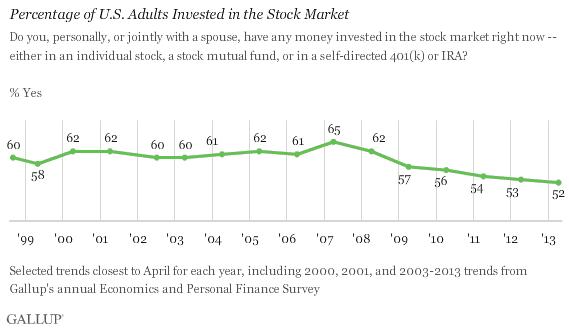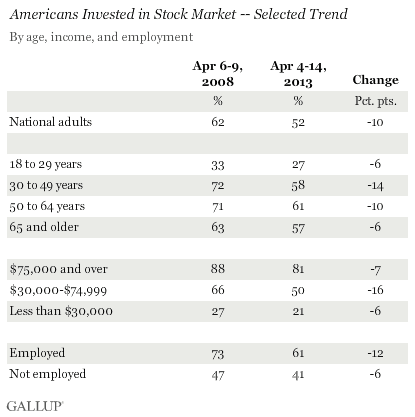PRINCETON, NJ -- Despite strong gains in the stock market over the past year, and the Dow Jones Industrial Average's reaching record highs in the past month, stock ownership among U.S. adults is at its lowest level in Gallup trends since 1998, essentially unchanged from a year ago. Just over half of Americans, 52%, now say they personally, or jointly with a spouse, own stock outright or as part of a mutual fund or self-directed retirement account.

This finding comes from Gallup's annual Economy and Finance survey, conducted April 4-14. The Dow rose about 250 points over the course of the field period, to 14,865, and has since closed above 15,000 for the first time. When Gallup last measured U.S. stock ownership, in April 2012, the Dow was closer to 13,000.
Americans' ownership of stock may, in fact, be more a function of their ability to buy it, than of whether its value is soaring. Between 1998 and 2008, a period of relatively modest unemployment, Gallup, with one exception, found at least 60% of Americans reporting that they owned stock. That changed in April 2009, at the same time the nation's economy was descending into recession and experiencing a near-doubling of the unemployment rate compared with April 2008. By April 2012, with unemployment still elevated at 8.1%, stock ownership had fallen to 53%. It remains at about that level today, perhaps indicating that the nation's current 7.5% unemployment rate, while improved, is still too high to support broader stock ownership.

Biggest Drops in Ownership Seen Among Middle-Aged and Middle-Income Groups
Majorities of Americans 30 and older, as well as those in households earning $30,000 or more per year, own stock, compared with no more than a third of their younger and lower-income counterparts. Similarly, employed Americans are much more likely than all non-employed Americans (including retirees, homemakers, and students, in addition to the unemployed) to own stock.
These patterns mirror what Gallup found in April 2008, when overall stock ownership was 10 percentage points higher than it is today, at 62%. However, the subsequent decline has been sharpest among 30- to 49-year-olds, as well as among middle-income Americans, the groups for whom stock ownership five years ago may have been the biggest financial stretch.

Bottom Line
Although the stock market is on a tear, creating new wealth for millions currently invested in it, nearly half of U.S. adults are on the sidelines. That may be particularly irksome to the middle-income and young middle-aged Americans who were previously invested.
While soaring stock values may be an incentive to jump back into the market, continued high unemployment appears to be acting as a barrier. Without a job, some Americans may simply be unable to afford stock investments, while others may fear the market is still too risky as long as joblessness remains a national problem.
Survey Methods
Results for this Gallup poll are based on telephone interviews conducted April 4-14, 2013, with a random sample of 2,017 adults, aged 18 and older, living in all 50 U.S. states and the District of Columbia.
For results based on the total sample of national adults, one can say with 95% confidence that the maximum margin of sampling error is ±3 percentage points.
Interviews are conducted with respondents on landline telephones and cellular phones, with interviews conducted in Spanish for respondents who are primarily Spanish-speaking. Each sample of national adults includes a minimum quota of 50% cellphone respondents and 50% landline respondents, with additional minimum quotas by region. Landline telephone numbers are chosen at random among listed telephone numbers. Cellphone numbers are selected using random digit dial methods. Landline respondents are chosen at random within each household on the basis of which member had the most recent birthday.
Samples are weighted to correct for unequal selection probability, nonresponse, and double coverage of landline and cell users in the two sampling frames. They are also weighted to match the national demographics of gender, age, race, Hispanic ethnicity, education, region, population density, and phone status (cellphone only/landline only/both, cellphone mostly, and having an unlisted landline number). Demographic weighting targets are based on the March 2012 Current Population Survey figures for the aged 18 and older U.S. population. Phone status targets are based on the July-December 2011 National Health Interview Survey. Population density targets are based on the 2010 census. All reported margins of sampling error include the computed design effects for weighting.
In addition to sampling error, question wording and practical difficulties in conducting surveys can introduce error or bias into the findings of public opinion polls.
View methodology, full question results, and trend data.
For more details on Gallup's polling methodology, visit www.gallup.com.
